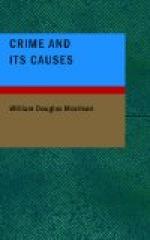The results of my investigations do not, however, bear out the commonly accepted view that crimes against property increase in the depth of winter. As far as this law relates to crime in France it may be correct; the statistical inquiries of Guerry, Ferri, and Corre point to that conclusion. On the other hand, as far as the law relates to England, I have serious doubts as to its validity. In the county of Surrey, in the year 1888-89, not only more crimes against the person, but also more crimes against property were committed in July than in January. In the former month, as compared with the latter, cases of felony increased 20 per cent.; and if Surrey is to be taken as a fairly typical English county—which there is every reason to believe it is—we have before us the remarkable fact that there are more offences against property in summer than in winter. The current opinion that winter is the most criminal period of the year is entirely fallacious, and it is extremely probable that it is equally fallacious to imagine that property is less sate when the days are short and the nights long.
But while property, on the whole, in more safe in winter than in summer, the offences committed against it in winter are, as a rule, of a more serious character. This, at least, is the conclusion which I should be inclined to draw, from the fact that there are more indictable offences—that is to say, offences not tried by a magistrate, but by a judge and jury—in the six months between October and March than in the summer six months. For the year ended September, 1888, which is an average year, there were fully 2000 more indictable offences in the winter six months than in the summer six months. As a considerable proportion of indictable offences consist in crimes against property of the nature of housebreaking and burglary, it is very probable that these crimes are most prevalent in winter. But if all kinds of offences against property, petty as well as grave, are thrown together, and calculated under one head, it comes out that these offences are most numerous in summer.
The only kind of crime that increases in Surrey in winter is vagrancy; the growth of this offence for the years I have mentioned in January, as contrasted with July was 60 per cent. The development of vagrancy in the cold months is partly owing to the fact that work is not so easily procured in the cold weather; and a certain percentage of the population, mainly dependent for subsistence on casual and irregular




